第三届全国小学英语优质课教案
- 格式:doc
- 大小:70.00 KB
- 文档页数:6
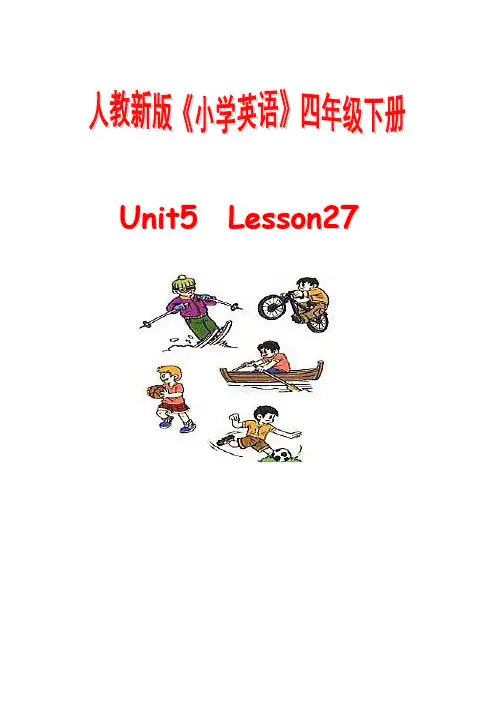
U n i t5L e s s o n27新版《小学英语》四年级下册Unit5 Lesson27一.教学指导思想:基础教育阶段英语课程强调从学生的兴趣、生活经验和认知水平出发,倡导体验、实践、参与、合作与交流的学习方式和任务型的教学途径,发展学生综合语言运用能力,使语言学习的过程成为学生形成积极情感态度、主动思维和大胆实践、提高跨文化意识和形成自主学习能力的过程。
《新课标》中明确指出“教学设计要力求满足不同类型和不同层次学生的需求,是每个学生的身心得到健康的发展。
”面向全体学生的核心思想是使每一个学生都得到发展。
因此,义务教育阶段的英语课程应该是为每一个学生开设的,所设计的教育目标也应该是多数学生能够达到的。
当然,在保证课堂面向全体学生的同时,也应该积极创造条件,来满足那些有更大学习潜力的学生的需要。
本节课正是基于这样的指导思想进行教学设计的。
结合本课要求,我设计了一些与学生学习、生活紧密结合的活动情景,为学生提供了一些相关的、迁移新知识点的练习任务,促使学生运用所学知识,实现知识的迁移、活学活用。
在活动中,能够组织好学生小组合作活动,使学生在有趣的任务活动中体验师生、生生之间的多向交流,发挥小组合作学习的优势,进行有意义的练习与实践,充分发挥他们的学习主体性。
二.教学背景分析:本课教学内容为人教新版小学英语四年级下册第五单元第29课,要求学生掌握What are you interested in? 及回答I’m interested in….I enjoy….功能句型。
课文背景为class meeting。
授课时间正好赶上我校即将召开英语课家长开放日,我将展示学生的兴趣爱好作为开放日班会的主题。
课文背景与学生实际生活紧密联系,为本课教学提供了极好契机。
本课的授课对象是小学四年级的学生,他们从二年级开始学习本套教材。
本课的教学设计强调从学生的学习兴趣出发,采用小组合作的学习方式,课堂评价贯穿始终,让学生在小组活动中,通过唱、做、写、说、演等多种手段学习和使用英语,完成学习任务。
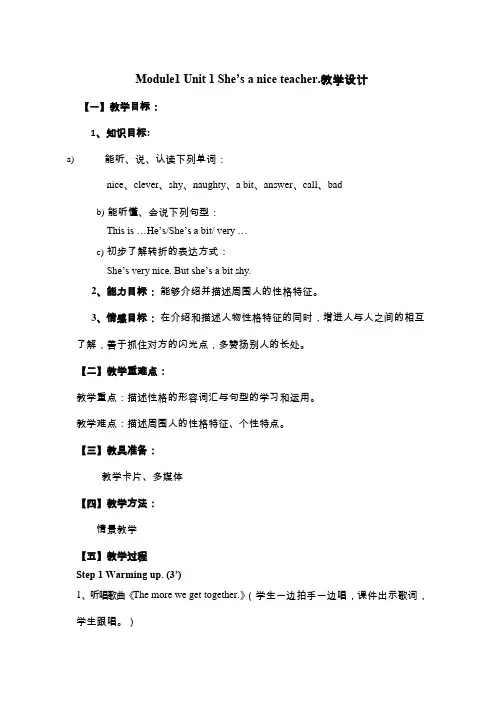
Module1 Unit 1 She’s a nice teacher.教学设计【一】教学目标:1、知识目标:a)能听、说、认读下列单词:nice、clever、shy、naughty、a bit、answer、call、badb)能听懂、会说下列句型:This is …He’s/She’s a bit/ very …c)初步了解转折的表达方式:She’s very nice. But she’s a bit shy.2、能力目标:能够介绍并描述周围人的性格特征。
3、情感目标:在介绍和描述人物性格特征的同时,增进人与人之间的相互了解,善于抓住对方的闪光点,多赞扬别人的长处。
【二】教学重难点:教学重点:描述性格的形容词汇与句型的学习和运用。
教学难点:描述周围人的性格特征、个性特点。
【三】教具准备:教学卡片、多媒体【四】教学方法:情景教学【五】教学过程Step 1 Warming up. (3’)1、听唱歌曲《The more we get together.》(学生一边拍手一边唱,课件出示歌词,学生跟唱。
)【设计意图】:通过师生齐唱唱英文歌,拉近师生的距离,渲染课堂气氛。
并进一步引出本模块的话题:朋友。
T: This is a song about friends. Today, we will talk about our friends.Step 2:Presentation(4’)1、T: Boys and girls. look ,(出示幻灯片)These are my friends. This is MeiYangyang. She’s very nice.出示单词nice。
板书:nice 采用先读rice 再读nice 的方法学习单词,教师领读该句型,出示害羞的动画引出句型Butshe’s a bit shy.教师板书a bit 和shy,领读单词及句型。
并告诉学生:本节课我们学习如何描述人物的性格,然后我们能够介绍自己的朋友。
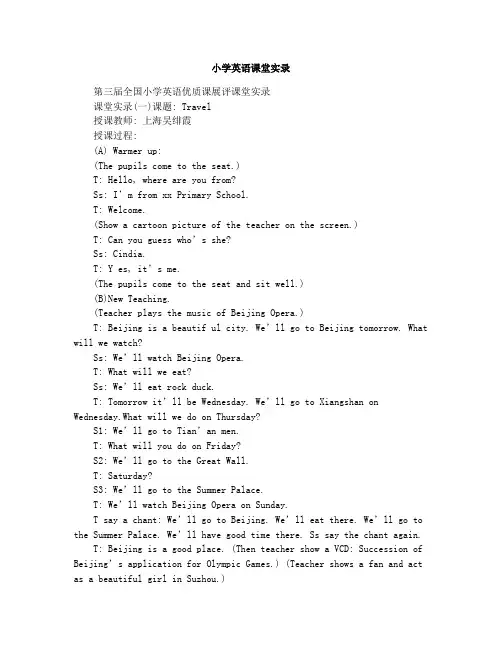
小学英语课堂实录第三届全国小学英语优质课展评课堂实录课堂实录(一)课题: Travel授课教师: 上海吴绯霞授课过程:(A) Warmer up:(The pupils come to the seat.)T: Hello, where are you from?Ss: I’m from xx Primary School.T: Welcome.(Show a cartoon picture of the teacher on the screen.)T: Can you guess who’s she?Ss: Cindia.T: Y es, it’s me.(The pupils come to the seat and sit well.)(B)New Teaching.(Teacher plays the music of Beijing Opera.)T: Beijing is a beautif ul city. We’ll go to Beijing tomorrow. What will we watch?Ss: We’ll watch Beijing Opera.T: What will we eat?Ss: We’ll eat rock duck.T: Tomorrow it’ll be Wednesday. We’ll go to Xiangshan on Wednesday.What will we do on Thursday?S1: We’ll go to Tian’an men.T: What will you do on Friday?S2: We’ll go to the Great Wall.T: Saturday?S3: We’ll go to the Summer Palace.T: We’ll watch Beijing Opera on Sunday.T say a chant: We’ll go to Beijing. We’ll eat there. We’ll go to the Summer Palace. We’ll have good time there. Ss say the chant again.T: Beijing is a good place. (Then teacher show a VCD: Succession of Beijing’s application for Olympic Games.) (Teacher shows a fan and act as a beautiful girl in Suzhou.)T: Where am I from?Ss: Suzhou.T: Where have you visited in Suzhou? Can you say something?S1: LiuY uan.S2: Shi Zilin.S3: Han Shansi.T: Y ou have some pictures on your desk. You can say where you will go.(The pupils say the sentences in the groups.)T: Where will you go?S1: I’ll go to Liu Y uan.T: What will you see?S1: I’ll see many flowers.T: There are many beautiful places in Suzhou. Have you got friends in other city?Ss: Y es.(Teacher shows a postcard.)T: Look at the postcard. On the postcard what can we write?S1: We are in Suzhou.(Teacher writes the sentence on the card.)T: Suzhou is a beautiful city. There are lots of trees. I love this city.(Ss write the postcards in groups and teacher plays the tape of the music.)Then each group give a report.(Teacher shows a picture of Hanshan Temple.)T: What’s this?Ss: Hanshan Temple.T: I love the place. Do you know why? (Play the tape of music)T: Do you want to Hanshan Temple? Look at the map of Suzhou. Hanshan Temple is here. (Show the map of Suzhou and Hanshan Temple.) T: How can we go there? Walk there? By foot? No.S1: We’ll go there by car.S2: We’ll go there by bike.T: And?S3: We’ll go there by motorcycle.S4: We’ll go there by car.T: Look, this is a plan for visiting Suzhou. Let’s finish this form together.(Show a big form on the blackboard.)A Plan For V isiting Suzhouwherewhenhowphotos card(Teacher and the pupils finish the form together. And the pupils come to the front and stick the photos and cards in the form. Thenpupils give a report.)T: Welcome to Suzhou.课堂实录(二)课题:Festivals授课教师四川何霞Ⅰ.Warming up:T: Good morning, boys and girls.Ss: Good morning, teacher.Ⅱ.New Teaching:T: What do you know about some festivals?S1: Children’s Day.T: Good.S2: Teacher’s Day.T: Wonderful.T: What is the most important festivals in China?S3: Spring Festival.T: What is the most important festivals in USA?S3: Christmas.T: Let’s say something about Christmas.S4: Snow.S5: Tree.S6: Presents.S7: Food.(板书)T: I have a student. His English is poor. His name is Jason. Now there is a letter. Let’s read it and help him. (教师领读,学生跟读。
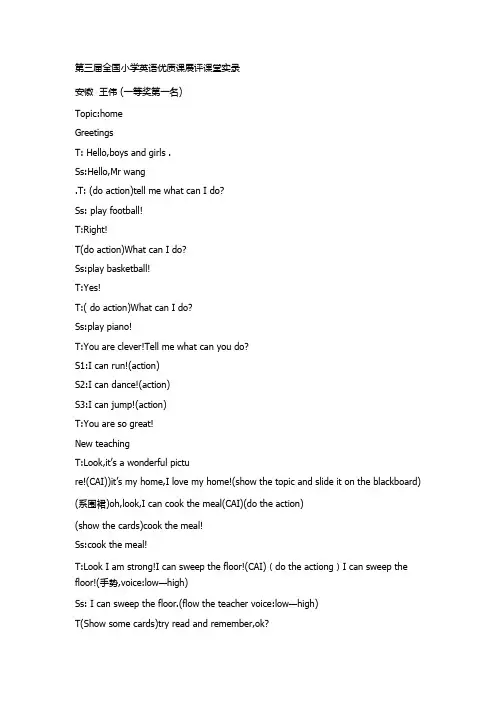
第三届全国小学英语优质课展评课堂实录安徽王伟 (一等奖第一名)Topic:homeGreetingsT: Hello,boys and girls .Ss:Hello,Mr wang.T: (do action)tell me what can I do?Ss: play football!T:Right!T(do action)What can I do?Ss:play basketball!T:Yes!T:( do action)What can I do?Ss:play piano!T:You are clever!Tell me what can you do?S1:I can run!(action)S2:I can dance!(action)S3:I can jump!(action)T:You are so great!New teachingT:Look,it’s a wonderful picture!(CAI))it’s my home,I love my home!(show the topic and slide it on the bl ackboard)(系围裙)oh,look,I can cook the meal(CAI)(do the action)(show the cards)cook the meal!Ss:cook the meal!T:Look I am strong!I can sweep the floor!(CAI)(do the actiong)I can sweep the floor!(手势,voice:low—high)Ss: I can sweep the floor.(flow the teacher voice:low—high)T(Show some cards)try read and remember,ok?Ss:ok!T:let’s begin!go!(show the cards) cook the meal(do the action)Ss:cook the meal(do the action)T:water the flower(show the card, do the action)Ss:water the flower(do the action)T:wash the clothes(show the card, do the action)Ss:wash the clothes(do the action)T:Who can remember?read and act!S1:cook the meal!(T give the card to him)S2:water the flower! (T give the card to him)S3:wash the clothes! (T give the card to her)T:Oh,where’s my cards?let me guess!(ask the pupil)T:Can you cook the meal?S4:No,I can’t.T:Can you cook the meal?S5:No,I can’t.T: Oh,I forgot! Who can help me?S6: Can you cook the meal?S1: Yes,I can.S7:Can you sweep the floor?S8:No,I can’t.S7:Can you sweep the floor?S2:Yes,I can.S9:Can you wash the clothes?S3:Yes,I can.T:You are so cool!look ,let’s go!(手势,voice low—high)Can you wash the clothes?Ss: Can you wash the clothes?(flow the teacher, 手势,voice low—high) T:who can do it ?(手势) come to front!S10: let’s go!(手势,voice low—high)Can you wash the clothes?Ss: Can you wash the clothes?(flow the teacher, 手势,voice low—high)T:wonderful!You should say:yes!S10:Yes!(do the actin)T:Who else?S11: let’s go!(手势,voice low—high)Can you wash the clothes?Ss: Can you wash the clothes?(flow the teacher, 手势,voice low—high)S11:Yes!T:You have done a good job!Now,I will give a paper to you,listen to the tape ,then answer the question on it,ready?Ss:Yes!T;Go!(tape) Amy:Hello,Sam! Sam:Hello!A:Can you water the flower? S:Yes,I can.A:Can you cook the meal? S:No.I can’t.A:What do your parents do at home?Can your father cook themeal? S:No,he can’t.A:Can your mother cook the meal? S:Of course!Sometimes,my parents wash the clothes,?together.T:Ok,change your ideas by yourgroup.Then answer the question.>T:let’s look the question,together.Can Sam water the flower?Ss:No,he can’t.T:Can Sam cook the meal?Ss:No,he can’t.T:Who can cook the meal?Ss:Sam’s mother can cook the meal.T:You are so clever!Now let’s play a game! Who can come to front?(let the pupil come to the front,give a card tohim,then let him act.)S12:(Do the action)guess!S13:Can you dance?S12:No,I can’t.S14:Can you water the flower?S12:Yes,I can.S14:Yes!(practice play football,brush teath,cook the meal,play basketball in the same way)T:Who can do house work in your home?S15:my motherS16: my motherS17:my fatherS18:me!T:good we should do house work together,let’s make a house work plan,here’s the plan,finsh it by your groupWhat can you do?What can your father do?What can your mother do?Ss:Ask and answer in the group finsh the house work planT:let’s look the house plan of S16’s,let’s ask !Ss: What can you do?S16:I can sweep the floor.Ss: What can your father do?S16:He can wash the clothes.Ss: What can your mother do?S16:She can cook the meal.T:Good plan ,a happy family!let’s look and sing,do the actins together,ok?(CAI)Ss(look and sing do the action)Can you run?Yes,I can.Can you sing? Yes,I can.Can you dance?No,I can’t.T:Ok,are you happy today?Ss:Yes.T:let’s say yes(do action)Ss:Yes!(do action)上海吴绯霞课题: Travel授课过程:(A) Warmer up:(The pupils come to the seat.)T: Hello, where are you from?Ss: I’m from xx Primary School.T: Welcome.(Show a cartoon picture of the teacher on the screen.)T: Can you guess who’s she?Ss: Cindia.T: Yes, it’s m e.(The pupils come to the seat and sit well.)(B)New Teaching.(Teacher plays the music of Beijing Opera.)T: Beijing is a beautiful city. We’ll go to Beijing tomorrow. What will we watch? Ss: We’ll watch Beijing Opera.T: What will we eat?Ss: We’ll eat rock duck.T: Tomorrow it’ll be Wednesday. We’ll go to Xiangshan on Wednesday.What will we do on Thursday?S1: We’ll go to Tian’an men.T: What will you do on Friday?S2: We’ll go to the Great Wall.T: Saturday?S3: We’ll go to the Summer Palace.T: We’ll watch Beijing Opera on Sunday.T say a chant: We’ll go to Beijing. We’ll eat there. We’ll go to the Summer Palace. We’ll have good time there.Ss say the chant again.T: Beijing is a good place. (Then teacher show a VCD: Succession of Beijing’s application for Olympic Games.)(Teacher shows a fan and act as a beautiful girl in Suzhou.)T: Where am I from?Ss: Suzhou.T: Where have you visited in Suzhou? Can you say something?S1: LiuYuan.S2: Shi Zilin.S3: Han Shansi.T: You have some pictures on your desk. You can say where you will go.(The pupils say the sentences in the groups.)T: Where will you go?S1: I’ll go to Liu Yuan.T: What will you see?S1: I’ll see many flowers.T: There are many beautiful places in Suzhou. Have you got friends in other city? Ss: Yes.(Teacher shows a postcard.)T: Look at the postcard. On the postcard what can we write?S1: We are in Suzhou.(Teacher writes the sentence on the card.)T: Suzhou is a beautiful city. There are lots of trees. I love this city.(Ss write the postcards in groups and teacher plays the tape of the music.)Then each group give a report.(Teacher shows a picture of Hanshan Temple.)T: What’s this?Ss: Hanshan Temple.T: I love the place. Do you know why? (Play the tape of music)T: Do you want to Hanshan Temple? Look at the map of Suzhou. Hanshan Temple is here. (Show the map of Suzhou and Hanshan Temple.)T: How can we go there? Walk there? By foot? No.S1: We’llS2: We’ll go there by bike.T: And?S3: We’ll go there by motorcycle.S4: We’ll go there by car.T: Look, this is a plan for visiting Suzhou. Let’s finish this form together.(Show a big form on the blackboard.)A Plan For Visiting Suzhouwherewhenhowphotos card(Teacher and the pupils finish the form together. And the pupils come to the front and stick the photos and cards in the form. Then pupils give a report.)T: Welcome to Suzhou四川何霞课题:FestivalsⅠ.Warming up:T: Good morning, boys and girls.Ss: Good morning, teacher.Ⅱ.New Teaching:T: What do you know about some festivals?S1: Children’s Day.T: Good.S2: Teacher’s Day.T: Wonderful.T: What is the most important festivals in China?S3: Spring Festival.T: What is the most important festivals in USA?S3: Christmas.T: Let’s say something about Christmas.S4: Snow.S5: Tree.S6: Presents.S7: Food.(板书)T: I have a student. His English is poor. His name is Jason. Now there is a letter. Let’s read it and help him.(教师领读,学生跟读。
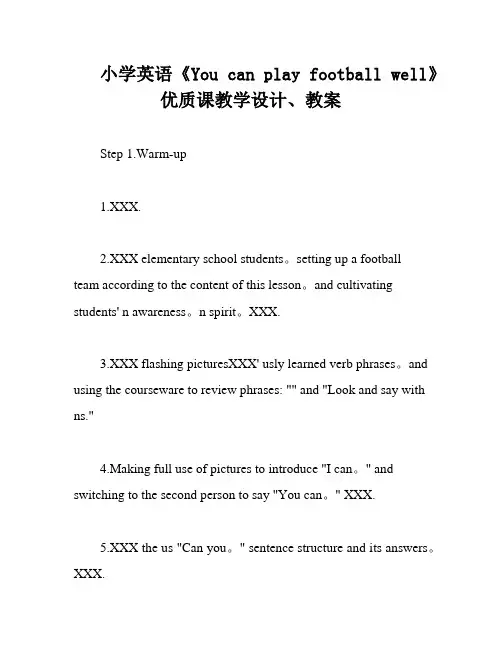
小学英语《You can play football well》优质课教学设计、教案Step 1.Warm-up1.XXX.2.XXX elementary school students。
setting up a footballteam according to the content of this lesson。
and cultivating students' n awareness。
n spirit。
XXX.3.XXX flashing picturesXXX' usly learned verb phrases。
and using the courseware to review phrases: "" and "Look and say with ns."4.Making full use of pictures to introduce "I can。
" and switching to the second person to say "You can。
" XXX.5.XXX the us "Can you。
" sentence structure and its answers。
XXX.Step 2.1.Watching a video of people playing basketball。
and asking students if they can play basketball.2.XXX.During the video。
students watch with sity and ns。
perceiving and understanding the text as a whole。
The video captures their n and helps them learn the key language points of the lesson.XXX recording。
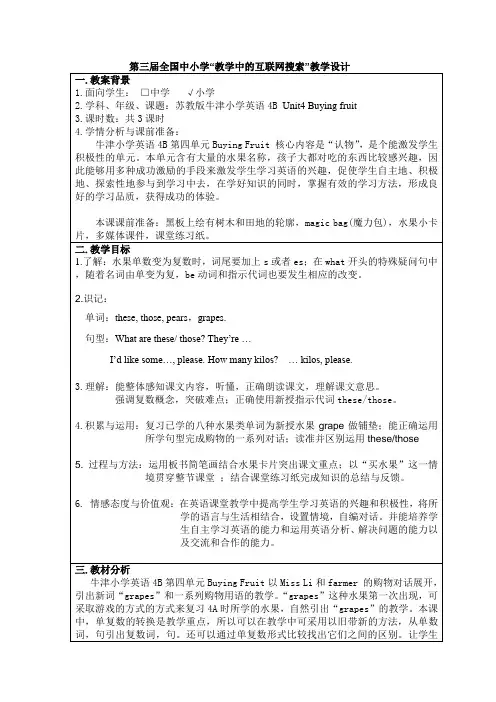
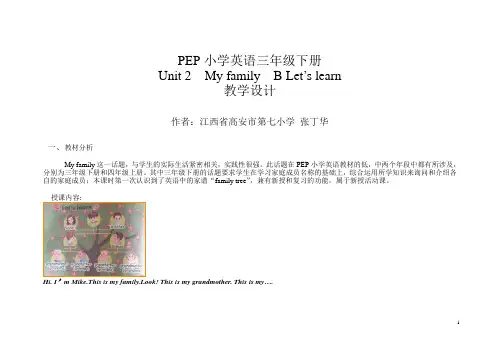
PEP小学英语三年级下册Unit 2 My family B Let’s learn教学设计作者:江西省高安市第七小学张丁华一、教材分析My family这一话题,与学生的实际生活紧密相关,实践性很强。
此话题在PEP小学英语教材的低,中两个年段中都有所涉及,分别为三年级下册和四年级上册。
其中三年级下册的话题要求学生在学习家庭成员名称的基础上,综合运用所学知识来询问和介绍各自的家庭成员;本课时第一次认识到了英语中的家谱“family tree”,兼有新授和复习的功能,属于新授活动课。
授课内容:Hi. I’m Mike.This is my family.Look! This is my grandmother. This is my….二、教学目标1、知识目标A、能听懂,认读,会说单词:sister,brother, grandmother(grandma),grandfather(grandpa);B、了解英文中家庭称呼里一词多义的现象和中西方家谱结构的差异。
2、技能目标C、能熟练地运用“Hi. I’m …. This is my family. Look! This is my….”进行语言实践;D、学生合作完成学习任务,注重交际功能。
3、情感目标E、了解家庭成员间的基本关系,激发学生热爱生活和家人的情感;F、了解中西文化差异,提高国际理解意识,养成和谐和健康向上的品格。
三、重难点1、能听懂,认读,会说单词:sister,brother, grandmother(grandma),grandfather(grandpa);并了解英文中家庭称呼里一词多义的现象和中西方家谱结构的差异是本课的教学重点2、能熟练地运用“Hi. I’m …. This is my family. Look! This is my….”来介绍自己的家人,进行语言实践,形成自己的交际策略是本课的教学难点。
四、教学辅助手段1、学生的家庭照片2、录音带3、多媒体教学课件T’s activities 设计意图Ss’ activitiesStep 1: 情境导入Warming up1. T: Good morning, children! How are you?Good news for you! Today we will have “A Family Party”. Look, children. There are so many families here today.Do you know them? Guess! Whose families are they?Step 2: 新课呈现Presentation1. T: Yes! Look! This is our friend’s family. 指着Mike的头像问道:Who is he? Do you know them? (Shows picture on the screen.) 以“班级要开展家庭联谊会,向大家介绍你的家人”作为开场白,播放一些学生的家庭照片,引出本课主题“Myfamily ”。
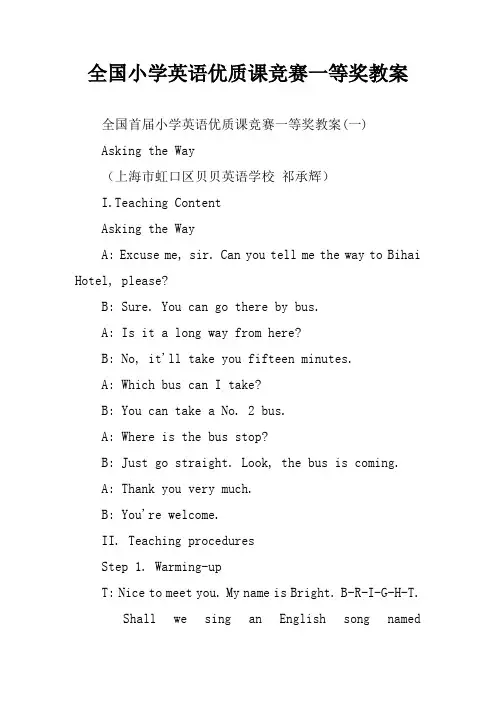
全国小学英语优质课竞赛一等奖教案全国首届小学英语优质课竞赛一等奖教案(一)Asking the Way(上海市虹口区贝贝英语学校祁承辉)I.Teaching ContentAsking the WayA: Excuse me, sir. Can you tell me the way to Bihai Hotel, please?B: Sure. You can go there by bus.A: Is it a long way from here?B: No, it'll take you fifteen minutes.A: Which bus can I take?B: You can take a No. 2 bus.A: Where is the bus stop?B: Just go straight. Look, the bus is coming.A: Thank you very much.B: You're welcome.II. Teaching proceduresStep 1. Warming-upT: Nice to meet you. My name is Bright. B-R-I-G-H-T.Shall we sing an English song named"Bingo", and try to change the' word "Bingo" with my name "Bright"?Step 2. PresentationT: I'm new here, when I arrived at the airport, I heard someone said "对不起"(注①),"早晨好"(注②).I really want to know their meanings in English. Could you help me?S: "对不起" is "Excuse me" and "早晨好" is "Good morning".T: Thanks a lot. And now could you tell me something about your city? I want to travel in this city, but I don't know where I should go.S1: Bai Lian Dong Park.S2: Fisher Girl.S3: Jiuzhou Town.T: Good. But I want to find a hotel now.Please do me a favour. Can you tell me the names of some hotels in this city?S1: XX Hotel.S2: Yindu Hotel.S3: Bihai Hotel.(The teacher takes notes while the students arespeaking.)Step 3. New structures learningT: They all sound very nice. But how can I get there, by bus or by bike?S: By bus.T: And how long will it take me to get there? Maybe fifteen minutes is enough.(The teacher looks at the watch and gives the students a gesture.)1) Draw a stick-figure picture to help the students understand the meaning ofthe sentence:"It'll take someone some time to do something."2) Write the sentence "It'll take you fifteen minutes. " on the blackboard, andhave the students imitate the sentence.3) A guessing game:T: Please look at these pictures and guess "How long will it take me to ...?"T: How long will it take me to have a football match?S1: It'll take you ninety minutes.T: Yes.4) Get the students to listen to the recording of the dialogue, in order tointroduce the new sentence: "Just go straight."5) Use the multi-media to help the students understand the meaning of thesentence "Go straight."6) Write the sentence on the blackboard, and have the students imitate thesentence: "Just go straight."Step 4. Practice1) Ask the students to listen to the dialogue once more, then ask them to repeatafter the tape, first individually and then in pairs.2) Encourage the students to read their dialogue with their deskmates.Step 5. ConsolidationT: You know I'm from Shanghai. Maybe in the future you'll go to Shanghai, soI've prepared some photographs for you.1) Show the photographs of "Nanjing Road", "udong New Area" and "the Bund" to the students.2) Get the students to ask the teachers from Shanghai something they don'tknow, such as directions, transportations in Shanghai.3) Ask some students to introduce their tour plans to Shanghai.注①、注②:因竞赛在珠海举行,授课教师用广东话说“对不起”和“早晨好”。
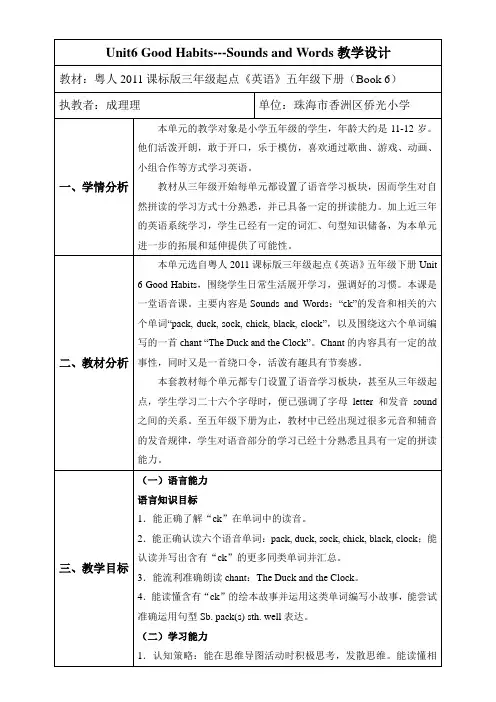
设计意图:通过单词抢答,让同学们集中注意力,快速感知,复习旧知,为后面的学习做好铺垫。
Step ⅢPresentation 1.Watch a video教师播放Alphablocks《字母盒子》视频“c” 和“k”进行足球比赛的片段:一开始“c”和“k”比赛之初两人水平不相上下,打成平局。
接着“c”“k”团结起来,组合在一起成“c k”,和他人进行比赛,最终赢得胜利,由此引出本课新知“ck”的学习。
设计意图:通过生动有趣的视频故事,不仅能激发学生的好奇心和积极性,更能自然地从复习“c” 和“k”的语音知识过渡到学习本课重点“ck”上来,让学生感知纯正发音的同时发现发音规律。
2.Match and read出示元音“a, e, i, o, u”和字母“ck”组合的积木,引导学生拼读元音和“ck”的组合并进行小组练习,然后全班展示。
设计意图:先将元音和“ck”组合进行拼读,后面作为整体再和辅音组合进行拼读,这样由易到难,由少到多,有利于分解整体拼读的难度,同时也给学生更直观的拼读体验。
2.Brainstorm分别将辅音和元音+ck的组合分别放入两个圆圈中,学生通过小组讨论进行头脑风暴,有效组合单词,如“b+a ck---back”,“k+ick---kick”等,并写在纸上用思维导图的形式呈现出来,然后全班展示。
全班展示时教师使用手机拍照,通过app希沃授课助手同步上传至电脑屏幕。
最后教师总结:Mack在大家的帮助下已经整理好了他的积木玩具。
出示句子:“Mack packs his blocks well.” 学生朗读。
设计意图:学生通过字母组合,分类整合单词,学习新知。
不仅可以巩固所学语音知识,训练拼读能力,还能发挥学生学习的主观能动性,增强小组合作精神,鼓励学生大胆探索,激发学生的思维。
通过小结,出示句型Sb. pack(s) sth. well. 让学生初次感知,为后面的语言输出做好铺垫,同时渗透学生整理好积木的情感教育。
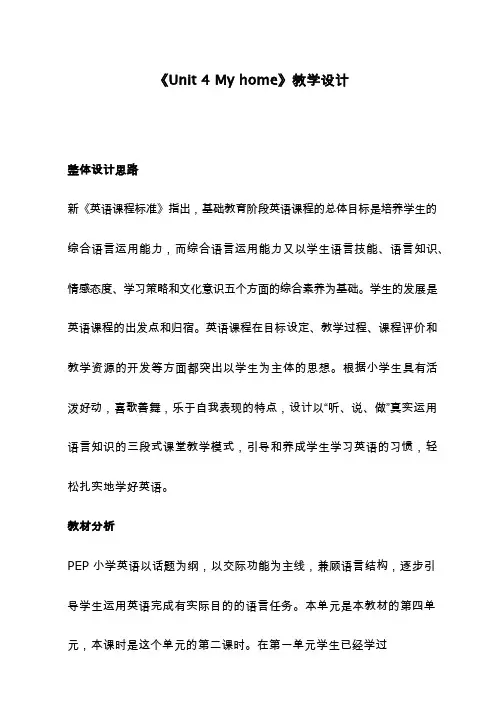
《Unit 4 My home》教学设计整体设计思路新《英语课程标准》指出,基础教育阶段英语课程的总体目标是培养学生的综合语言运用能力,而综合语言运用能力又以学生语言技能、语言知识、情感态度、学习策略和文化意识五个方面的综合素养为基础。
学生的发展是英语课程的出发点和归宿。
英语课程在目标设定、教学过程、课程评价和教学资源的开发等方面都突出以学生为主体的思想。
根据小学生具有活泼好动,喜歌善舞,乐于自我表现的特点,设计以“听、说、做”真实运用语言知识的三段式课堂教学模式,引导和养成学生学习英语的习惯,轻松扎实地学好英语。
教材分析PEP 小学英语以话题为纲,以交际功能为主线,兼顾语言结构,逐步引导学生运用英语完成有实际目的的语言任务。
本单元是本教材的第四单元,本课时是这个单元的第二课时。
在第一单元学生已经学过classroom 这个单词,所以可以通过合成词classroom 来导入bedroom,bathroom,living room 这几个单词和词组。
学情分析本节课的授课对象是小学四年级的学生,年龄大约在十岁左右,他们生性活泼好动,喜欢直观形象思维,对图片,视频和游戏十分感兴趣。
他们接触英语已经有一年了,具有初步的听说能力。
授课时,应注重趣味性与交际性相结合;同时为了激发他们的竞争与合作意识,我设以奖励的方式来评价他们的学习活动。
一、教学目标(一)、知识与技能目标1.学生能够听、说、认读4 个有关房间的单词或词组:bedroom, study, living room, kitchen。
2.学生能听懂并能在实际情境中灵活运用句型Is she in the …? Yes, she is.3.学生能够运用所学知识进行交际,发展学生听、说、读和运用的综合能力。
4.学生能够大胆参与英语课堂实践活动,培养合作交流的能力。
(二)、情感态度目标1.培养学生对英语学习有持续的热情,树立学习英语的自信心,敢于并乐于参加课堂实践活动。
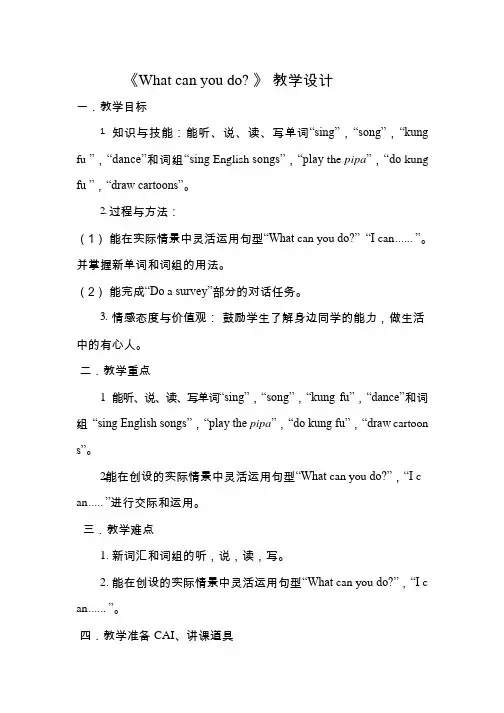
《What can you do? 》教学设计一.教学目标1.知识与技能:能听、说、读、写单词“sing”,“song”,“kung fu ”,“dance”和词组“sing English songs”,“play the pipa”,“do kung fu ”,“draw cartoons”。
2.过程与方法:(1)能在实际情景中灵活运用句型“What can you do?”“I can ...... ”。
并掌握新单词和词组的用法。
(2)能完成“Do a survey”部分的对话任务。
3.情感态度与价值观:鼓励学生了解身边同学的能力,做生活中的有心人。
二.教学重点1.能听、说、读、写单词“sing”,“song”,“kung fu”,“dance”和词组“sing English songs”,“play the pipa”,“do kung fu”,“draw cartoon s”。
2...能在创设的实际情景中灵活运用句型“What can you do?”,“I c an ..... ”进行交际和运用。
三.教学难点1.新词汇和词组的听,说,读,写。
2.能在创设的实际情景中灵活运用句型“What can you do?”,“I c an ...... ”。
四.教学准备CAI、讲课道具五.教学过程Step1 .Warm-up and lead-in(1)Greetings: Hello,boys and girls. Are you ready? OK, please give me a big smile.(2)Let’s doT:Look, what’s the weather like today? It’s cold, so let’s do, OK! Follow me, stand up , shake your body, clap your hands, sit down please!T:You see, I can stand up, I can clap hands, I can shake body, I can clap hands. I can do many things. I am wonderful. Now I let’s watch a video and try to answer “ What can Miss wu do in the video?”,请学生一起观看视频,通过视频找到答案,让学生初步整体感知本节课所教授的新知。
课题:Unit 4 What do you collect?的说课一、说教材1、教材来源本节课所选《What do you collect?》2、教材内容教材重点围绕收藏物品这一话题展开的。
围绕小孩子们通常收藏什么物品和展开话题。
而本课时要求学生掌握的是六种收藏品:sticker, comic, autograph, football,picture, postcard, stamp及句型What do you collect? I collect…3、教材的地位本单元的教学是围绕收藏物品这一生活习惯展开的。
在收藏品方面,学生已经在本册的第二单元学习Mascots,其实mascot也是可收藏的物品。
所以学生在运用互相询问收藏品这一句型时,就有更多的东西可以选择。
另一方面,通过引导学生谈论自己希望收藏的物品和数量目标。
也复习了第一单元所学得一般将来时,I’m going to…和I will的句型。
这样既引起了学生对自己原有信息的提取,又使交流活动更趋真实。
二、说目标.语言技能。
能在配图的帮助下理解故事的含义,能用英语就各自的收藏品进行初步的交流。
文化意识。
本节课在拓展环节向学生展示历届奥运会的吉祥物,从而让学生领略世界上几个重要国家或城市的象征物和吉祥物。
语言知识。
学生能听、说、读短语及单词sticker, comic,football picture, autograph, postcard, stamp能运用句型What do you collect? I collect…进行口语交际。
情感目标。
通过各种活动,帮助学生用英语完成学习任务,从而提高学生的学习成功感。
让学生积极参与,乐于交流。
同时让学生初步感受收藏文化以及收藏乐趣,引起其对收藏这一行为的兴趣。
学习策略。
在教学过程中,渗透自然拼读单词、聆听故事等认知策略的培养,同时设计任务为学生提供交际机会。
让学生能运用所学的英语进行表达、交流。
Book 3 Unit 3 Lesson 1 教学设计授课人:指导教师:一、教材分析:Unit 3主题是:Days of the week. Lesson 1 What day is today?的语言功能是询问今天是星期几;学习任务是What day is today? It’s … . 和从周一到周五这五个单词的正确区分。
二、学情分析:本课的教学对象是四年级学生。
通过一年的学习,有了一定的英语基础,学习热情较高。
在教学中,要根据学生的年龄特点和心理特征,设计一些有趣、有效的教学活动,让学生在活动中习得英语,同时培养学生良好的拼读习惯和自主学习、合作学习的能力。
三、教学目标:(一)知识目标1.能听懂、会说并认读下列单词:Monday, Tuesday, Wednesday, Thursday, Friday。
2.能听懂、会说并认读句子:What day is today? It’s … .(二)能力目标能在正确的语境中使用What day is today? It’s … .来询问今天是星期几?(三)情感目标培养学生在生活中运用所学英语的能力,激发学生的求知欲,善于和别人合作。
四、教学要点分析:(一)教学重点1.单词:Monday, Tuesday, Wednesday, Thursday, Friday的正确认读。
2.运用What day is today? It’s … .询问今天是星期几。
(二)教学难点能在句子What day is today? It’s ….中,正确区分使用单词:Monday, Tuesday, Wednesday, Thursday, Friday。
五、教学准备:1. 教具准备:一本一周的日历、多媒体课件、单词卡片。
2. 学具准备:学生每人一套周一到周五的单词卡、两人一套周一到周五的小日历。
六、教学过程:Step 1. Warmer:1.Enjoy a song: Days of the week.T: Do you like this song? The name of the song is “Days of the week”. (板书)Do you know “day”?(拿出日历)Monday is a day. Tuesday is a day. Wenesday is also a day. …One day, two days, three days… . Day means … . (用卡片教说day)T:(翻动七张日历)This is a week. So week is … . Now let’s enjoy this song.【设计意图】利用歌曲活跃课堂气氛,同时让学生先感知一下表示星期的单词,继而引出本单元的主题。
小学英语优质课教案设计小学英语优质课教案设计篇1教学目标:知识与能力:1、能听懂、会说“How tall are you? I’m 1.65meters. I’m taller than this one. Howtall is it?”并能在情景中正确运用。
2、能够知道meter的意思能够独立完成let’s try的练习过程与方法:学生能在合作沟通中使用新语言进行沟通情感与价值观:培育学生良好的英语学习习惯。
了解基本的计量单位的运用教学重点:掌握句型:How tall are you? I’m 1.65meters. I’m taller than this one. How tallis it?”教学难点:能在情景中正确运用所学句型并能完成调查表。
教具学具课件准备录音机及磁带、图片、学生自备一张调查表第几课时:2探索流程个性添加(教学反思)1. preparation(预习)1.日常口语练习。
2.复习单词:taller、longer、older、younger 、shorter2. presentation(新课呈现)(1)Let’s try老师播放录音,学生独立完成练习并核对答案(2)Let’s talka.生阅读对话,并解释大意b.老师范读,学生跟读c.分组读,个别读回答问题d.播放录音,学到再次跟读3.practice(练习)(1).T: How tall are you? I’m 1.65metres.引导学生回答,并多加练习。
(2).做完后老师出示图片问How tall are you?请学生轮流回答。
(3).把图片出示给学生,让他们加强练习。
同桌或小组之间互相练习。
(4).学生两人分角色朗读课文对话。
4.homework(家庭拓展)(1).做本单元A Let’s talk部分的活动手册配套练习。
(2)听A Let’s talk部分的录音读给同伴、朋友或家长听。
板书设计作业布置Unit 1 How tall are you? 2How tall are you?I’m 164cm tall.You’re shorter than me.You’re 4cm taller than me. 1听A Let’s talk部分的录音读给同伴、朋友或家长听。
小学英语优质公开课教案〔通用14篇〕小学英语优质公开课教案〔通用14篇〕小学英语优质公开课教案篇1一、教学目的:1、掌握there be构造所表达的意义。
2、能听懂和看懂包含there be句型的简短对话。
3、能运用学过词汇和there be句型来简单描绘一下某处有某物。
二、重点难点:there be句型的肯定式、否认式一般疑问句及其答复方式。
三、教学过程:1、there be概念。
there be ...句型,表示的是“存在”,“某地有某人或某物”,其构造为there be(is,are)+某物/某人+某地。
2、be动词的用法。
单数名词和不可数名词用is,复数用are.3、there is的句子构造:there is a book on the desk.there is some water in the bottle.4、there are的句子构造:there are some pictures on the wall.小学英语优质公开课教案篇2教学目的:1.能听说、认读eye, face , ear, nose, mouth,这些关于身体部位的单词,并能用英语介绍自己身体的这几个局部2.初步理解表示接触的指示用语,能听懂,并按指令做出相应的动作。
3.激发学生学习兴趣,培养听说习惯和才能。
教学重点:关于头部的单词eye, face , ear, nose, mouth的学习。
教学难点:eye, face两个单词的元音因素容易发音不到位,老师可鼓励学生张大口型,互相检查。
mouth一词的尾音发音较难,老师可适当提醒学生,注意口型教学过程:step 1.warm up and revi-sion 1.greetings :hello,boys and girls! nice to meet you! sit down please!step 2.presentation1.利用多媒体展示学生感兴趣的动画人物“大耳朵图图”,让学生与图中人物进展口语交流let’s say “hello, tutu.”2.tu tu is so cute.look! this is tutu’s eye.并指着tutu的眼睛介绍。